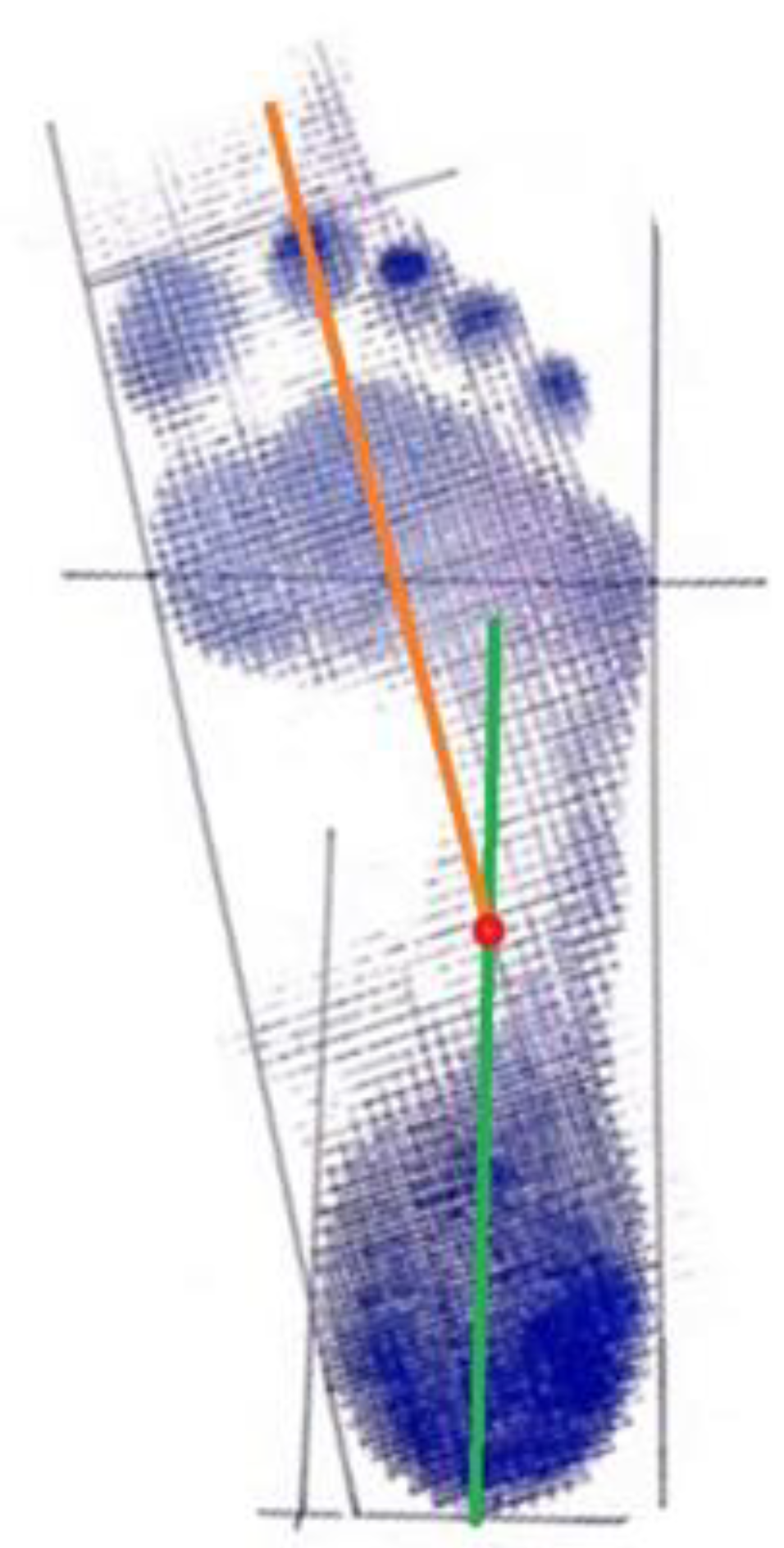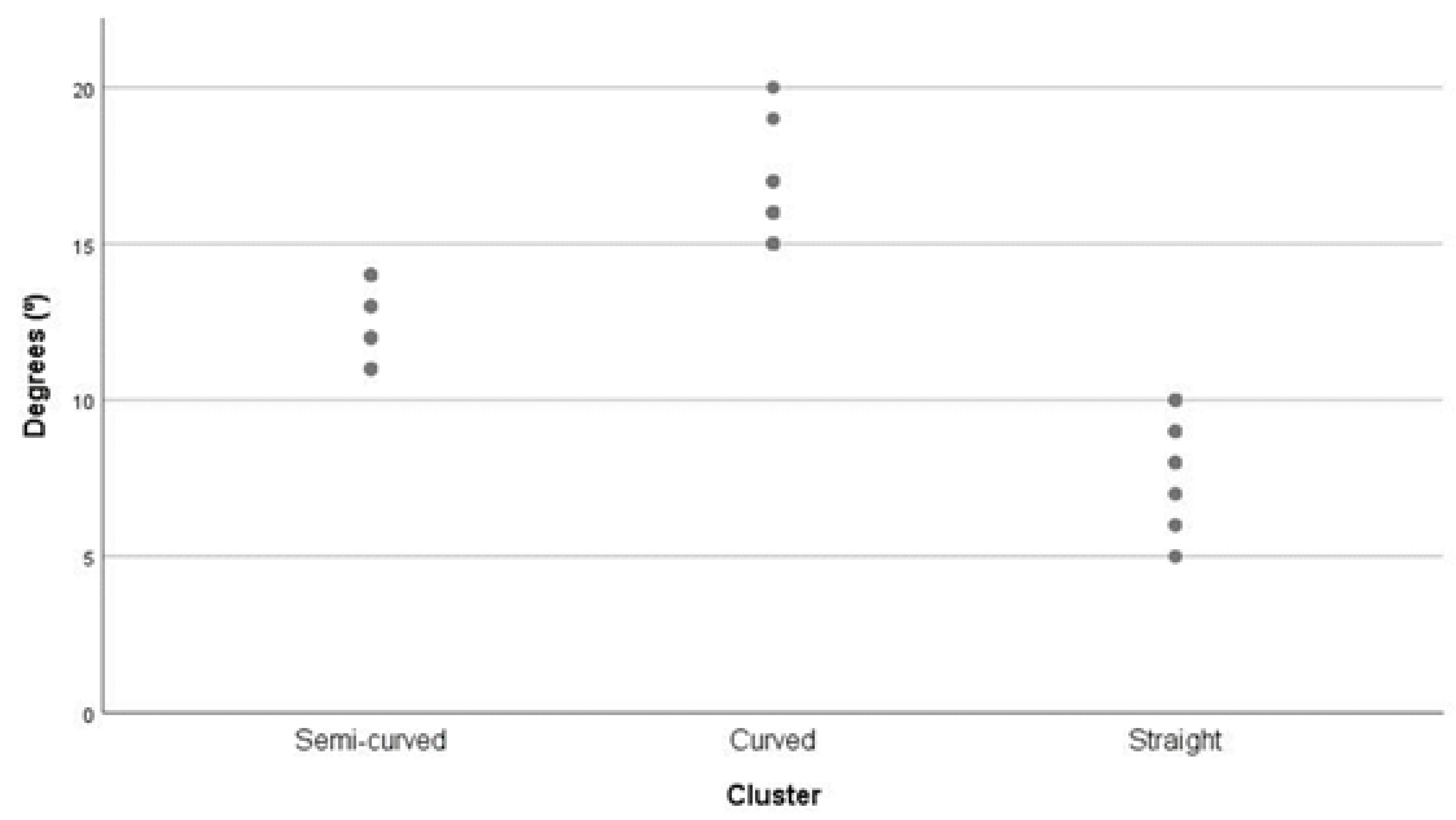Footprint Curvature in Spanish Women: Implications for Footwear Fit
Abstract
1. Introduction
2. Materials and Methods
2.1. Participants
2.2. Instrumentation and Procedure
2.3. Statistical Analysis
3. Results
3.1. Participant Characteristics
3.2. Cluster Analysis
4. Discussion
5. Conclusions
Author Contributions
Funding
Acknowledgments
Conflicts of Interest
References
- Dufour, A.B.; Broe, K.E.; Nguyen, U.S.D.T.; Gagnon, D.R.; Hillstrom, H.J.; Walker, A.H.; Kivell, E.; Hannan, M.T. Foot pain: Is current or past shoewear a factor? Arthritis Care Res. 2009, 61, 1352–1358. [Google Scholar] [CrossRef]
- Paiva de Castro, A.; Rebelatto, J.R.; Aurichio, T.R. The relationship between foot pain, anthropometric variables and footwear among older people. Appl. Ergon. 2010, 41, 93–97. [Google Scholar] [CrossRef]
- Bunch, R.P. Foot measurement strategies for fitting athletes. J. Test. Eval. 1988, 16, 407–411. [Google Scholar]
- López, D.L.; González, L.C.; Iglesias, M.E.L.; Canosa, J.L.S.; Sanz, D.R.; Lobo, C.C.; De Bengoa Vallejo, R.B. Quality of life impact related to foot health in a sample of older people with hallux valgus. Aging Dis. 2016, 7, 45–52. [Google Scholar] [CrossRef] [PubMed]
- Rodríguez-Sanz, D.; Tovaruela-Carrión, N.; López-López, D.; Palomo-López, P.; Romero-Morales, C.; Navarro-Flores, E.; Calvo-Lobo, C. Foot disorders in the elderly: A mini-review. Disease-a-Month 2018, 64, 64–91. [Google Scholar]
- Navarro-Flores, E.; Losa-Iglesias, M.; Becerro-de-Bengoa-Vallejo, R.; López-López, D.; Rodríguez-Sanz, D.; Palomo-López, P.; Calvo-Lobo, C. Translation and Test–Retest of the Spanish Podiatry Health Questionnaire (PHQ-S). Int. J. Environ. Res. Public Health 2018, 15, 2205. [Google Scholar] [CrossRef] [PubMed]
- Navarro-Flores, E.; Losa-Iglesias, M.E.; Becerro-de-Bengoa-Vallejo, R.; Lopez-Lopez, D.; Vilar-Fernandez, J.M.; Palomo-Lopez, P.; Calvo-Lobo, C. Transcultural Adaptation and Validation of the Spanish Bristol Foot Score (BFS-S). Aging Dis. 2018, 9, 861. [Google Scholar] [CrossRef] [PubMed]
- Chicharro-Luna, E.; Pomares-Gómez, F.J.; Ortega-Ávila, A.B.; Marchena-Rodríguez, A.; Blanquer-Gregori, J.F.J.; Navarro-Flores, E. Predictive model to identify the risk of losing protective sensibility of the foot in patients with diabetes mellitus. Int. Wound J. 2020, 17, 220–227. [Google Scholar] [CrossRef]
- Menz, H.B.; Roddy, E.; Marshall, M.; Thomas, M.J.; Rathod, T.; Peat, G.M.; Croft, P.R. Epidemiology of shoe wearing patterns over time in older women: Associations with foot pain and hallux valgus. J. Gerontol. -Ser. A Biol. Sci. Med. Sci. 2016, 71, 1682–1687. [Google Scholar] [CrossRef]
- Hurst, B.; Branthwaite, H.; Greenhalgh, A.; Chockalingam, N. Medical-grade footwear: The impact of fit and comfort. J. Foot Ankle Res. 2017, 10. [Google Scholar] [CrossRef]
- Kouchi, M. Analysis of foot shape variation based on the medial axis of foot outline. Ergonomics 1995, 38, 1911–1920. [Google Scholar] [CrossRef] [PubMed]
- KOUCHI, M.; TSUTSUMI, E. Relation between the medial axis of the foot outline and 3-D foot shape. Ergonomics 1996, 39, 853–861. [Google Scholar] [CrossRef]
- Calvo-Lobo, C.; Ramos García, A.; Losa Iglesias, M.; López-López, D.; Rodríguez-Sanz, D.; Romero-Morales, C.; Becerro-de-Bengoa-Vallejo, R. The Relationship between Shoe Fitting and Foot Health of Persons with Down Syndrome: A Case Control Study. Int. J. Environ. Res. Public Health 2018, 15, 983. [Google Scholar] [CrossRef] [PubMed]
- Müller, S.; Carlsohn, A.; Müller, J.; Baur, H.; Mayer, F. Static and dynamic foot characteristics in children aged 1-13 years: a cross-sectional study. Gait Posture 2012, 35, 389–394. [Google Scholar] [CrossRef] [PubMed]
- Ansuategui Echeita, J.; Hijmans, J.M.; Smits, S.; Van der Woude, L.H.V.; Postema, K. Age-related differences in women’s foot shape. Maturitas 2016, 94, 64–69. [Google Scholar] [CrossRef][Green Version]
- Domjanic, J.; Seidler, H.; Mitteroecker, P. A Combined Morphometric Analysis of Foot Form and Its Association with Sex, Stature, and Body Mass. Am. J. Phys. Anthropol. 2015, 157, 582–591. [Google Scholar] [CrossRef]
- Jurca, A.; Zabkar, J.; Dzeroski, S. Analysis of 1.2 million foot scans from North America, Europe and Asia. Sci. Rep. 2019, 9, 19155. [Google Scholar] [CrossRef]
- Hawes, M.R.; Sovak, D. Quantitative morphology of the human foot in a North American population. Ergonomics 1994, 37, 1213–1226. [Google Scholar] [CrossRef]
- Hawes, M.R.; Sovak, D.; Miyashita, M.; Kang, S.J.; Yoshihuku, Y.; Tanaka, S. Ethnic differences in forefoot shape and the determination of shoe comfort. Ergonomics 1994, 37, 187–196. [Google Scholar] [CrossRef]
- Sacco, I.C.N.; Onodera, A.N.; Bosch, K.; Rosenbaum, D. Comparisons of foot anthropometry and plantar arch indices between German and Brazilian children. BMC Pediatr. 2015, 15, 4. [Google Scholar] [CrossRef]
- Krauss, I.; Grau, S.; Mauch, M.; Maiwald, C.; Horstmann, T. Sex-related differences in foot shape. Ergonomics 2008, 51, 1693–1709. [Google Scholar] [CrossRef] [PubMed]
- Hill, M.; Naemi, R.; Branthwaite, H.; Chockalingam, N. The relationship between arch height and foot length: Implications for size grading. Appl. Ergon. 2017, 59, 243–250. [Google Scholar] [CrossRef] [PubMed]
- Xiong, S.; Goonetilleke, R.S.; Witana, C.P.; Lee Au, E.Y. Modelling foot height and foot shape-related dimensions. Ergonomics 2008, 51, 1272–1289. [Google Scholar] [CrossRef] [PubMed]
- Novak, B.; Mozina, J.; Jezersek, M. 3D laser measurements of bare and shod feet during walking. Gait Posture 2014, 40, 87–93. [Google Scholar] [CrossRef] [PubMed]
- Ito, K.; Maeda, K.; Fujiwara, I.; Hosoda, K.; Nagura, T.; Lee, T.; Ogihara, N. Dynamic measurement of surface strain distribution on the foot during walking. J. Mech. Behav. Biomed. Mater. 2017, 69, 249–256. [Google Scholar] [CrossRef] [PubMed]
- Levinger, P.; Murley, G.S.; Barton, C.J.; Cotchett, M.P.; McSweeney, S.R.; Menz, H.B. A comparison of foot kinematics in people with normal- and flat-arched feet using the Oxford Foot Model. Gait Posture 2010, 32, 519–523. [Google Scholar] [CrossRef]
- Buldt, A.K.; Levinger, P.; Murley, G.S.; Menz, H.B.; Nester, C.J.; Landorf, K.B. Foot posture and function have only minor effects on knee function during barefoot walking in healthy individuals. Clin. Biomech. 2015, 30, 431–437. [Google Scholar] [CrossRef]
- Buldt, A.K.; Levinger, P.; Murley, G.S.; Menz, H.B.; Nester, C.J.; Landorf, K.B. Foot posture is associated with kinematics of the foot during gait: A comparison of normal, planus and cavus feet. Gait Posture 2015, 42, 42–48. [Google Scholar] [CrossRef]
- Redmond, A.C. Foot Posture Index and Its Implications for Footwear Selection. In The Science of Footwear; Goonetilleke, R.S., Ed.; CRC Press, Taylor & Francis Group: Boca Raton, FL, USA, 2017; pp. 79–110. ISBN 978-1-138-07784-3. [Google Scholar]
- Lee, S.; Muller, C.C.; Stefanyshyn, D.; Nigg, B.M. Relative forefoot abduction and its relationship to foot length in vitro. Clin. Biomech. 1999, 14, 193–202. [Google Scholar] [CrossRef]
- Barton, C.J.; Bonanno, D.; Menz, H.B. Development and evaluation of a tool for the assessment of footwear characteristics. J. Foot Ankle Res. 2009, 2, 10. [Google Scholar] [CrossRef]
- Luximon, A.; Luximon, Y. Shoe-Last Design and Development. In The Science of Footwear; Goonetilleke, R.S., Ed.; CRC Press, Taylor & Francis Group: Boca Raton, FL, USA, 2017; pp. 193–212. ISBN 978-1-138-07784-3. [Google Scholar]
- Goonetilleke, R.S.; Luximon, A. Foot flare and foot axis. Hum. Factors 1999, 41, 596–607. [Google Scholar] [CrossRef] [PubMed]
- Luximon, A.; Goonetilleke, R.S. Dimensions for fitting footwear. In Proceedings of the IEA 2003 XVth Triennal Congress, Seoul, Korea, 24–29 August 2003. [Google Scholar]
- Rodrigo, A.S.; Goonetilleke, R.S.; Witana, C.P. Model based foot shape classification usign 2D foot outlines. Comput. Des. 2012, 44, 48–55. [Google Scholar]
- Domínguez, G.; Munuera, P.V.; Pod, L. Metatarsus adductus angle in male and female feet normal values with two measurement techniques. J. Am. Podiatr. Med. Assoc. 2008, 98, 364–369. [Google Scholar] [CrossRef] [PubMed]
- Witana, C.P.; Feng, J.; Goonetilleke, R.S. Dimensional differences for evaluating the quality of footwear fit. Ergonomics 2004, 47, 1301–1317. [Google Scholar] [CrossRef]
- Holt, G.R. Declaration of Helsinki—The World’s Document of Conscience and Responsibility. South. Med. J. 2014, 107, 407. [Google Scholar] [CrossRef]
- Menz, H.B. Two feet, or one person? Problems associated with statistical analysis of paired data in foot and ankle medicine. Foot 2004, 14, 2–5. [Google Scholar] [CrossRef]
- Domjanic, J.; Fieder, M.; Seidler, H.; Mitteroecker, P. Geometric morphometric footprint analysis of young women. J. Foot Ankle Res. 2013, 6, 27. [Google Scholar] [CrossRef]
- Xiong, S.P.; Goonetilleke, R.S. Midfoot shape for the design of ladies’ shoes. In Proceedings of the Conference on Biomedical Engineering, BME2006, Hong Kong, China, 21–23 September 2006; pp. 158–160. [Google Scholar]
- Paiva de Castro, A.; Rebelatto, J.R.; Aurichio, T.R. The relationship between wearing incorrectly sized shoes and foot dimensions, foot pain, and diabetes. J. Sport Rehabil. 2010, 19, 214–225. [Google Scholar] [CrossRef]
- Klein, C.; Groll-Knapp, E.; Kundi, M.; Kinz, W. Increased hallux angle in children and its association with insufficient length of footwear: a community based cross-sectional study. BMC Musculoskelet. Disord. 2009, 10, 159. [Google Scholar] [CrossRef]
- Menz, H.B.; Auhl, M.; Ristevski, S.; Frescos, N.; Munteanu, S.E. Evaluation of the accuracy of shoe fitting in older people using three-dimensional foot scanning. J. Foot Ankle Res. 2014, 7, 3. [Google Scholar] [CrossRef]
- Hayashi, R.; Hosoya, S. Effect of Improperly Sized Shoes on Gait. J. Fiber Bioeng. Inform. 2014, 7, 327–337. [Google Scholar]
- Redmond, A.C. Easy quantification of standing foot posture. Six item version FPI-6. In The Foot Posture Index-User Guide and Manual; Rachael Lowe; Physiopedia: London, UK, 2005; pp. 1–19. [Google Scholar]


| Variable | Mean (SD) | Minimum | Maximum |
|---|---|---|---|
| Age (years) | 29.13 (7.99) | 18 | 45 |
| Foot length (mm) | 231.63 (5.46) | 220 | 244 |
| Forefoot–rearfoot angle (degrees) | 12.00 (3.34) | 5 | 20 |
| Type of Angulation | N | Forefoot–Rearfoot Angle Mean (SD) |
|---|---|---|
| Curved | 29 | 16.03° (1.24°) |
| Semi-curved | 35 | 12.49° (1.12°) |
| Straight | 38 | 8.47° (1.56°) |
© 2020 by the authors. Licensee MDPI, Basel, Switzerland. This article is an open access article distributed under the terms and conditions of the Creative Commons Attribution (CC BY) license (http://creativecommons.org/licenses/by/4.0/).
Share and Cite
Alonso-Montero, C.; Torres-Rubio, A.; Padrós-Flores, N.; Navarro-Flores, E.; Segura-Heras, J.V. Footprint Curvature in Spanish Women: Implications for Footwear Fit. Int. J. Environ. Res. Public Health 2020, 17, 1876. https://doi.org/10.3390/ijerph17061876
Alonso-Montero C, Torres-Rubio A, Padrós-Flores N, Navarro-Flores E, Segura-Heras JV. Footprint Curvature in Spanish Women: Implications for Footwear Fit. International Journal of Environmental Research and Public Health. 2020; 17(6):1876. https://doi.org/10.3390/ijerph17061876
Chicago/Turabian StyleAlonso-Montero, Carolina, Anselén Torres-Rubio, Nuria Padrós-Flores, Emmanuel Navarro-Flores, and José Vicente Segura-Heras. 2020. "Footprint Curvature in Spanish Women: Implications for Footwear Fit" International Journal of Environmental Research and Public Health 17, no. 6: 1876. https://doi.org/10.3390/ijerph17061876
APA StyleAlonso-Montero, C., Torres-Rubio, A., Padrós-Flores, N., Navarro-Flores, E., & Segura-Heras, J. V. (2020). Footprint Curvature in Spanish Women: Implications for Footwear Fit. International Journal of Environmental Research and Public Health, 17(6), 1876. https://doi.org/10.3390/ijerph17061876






